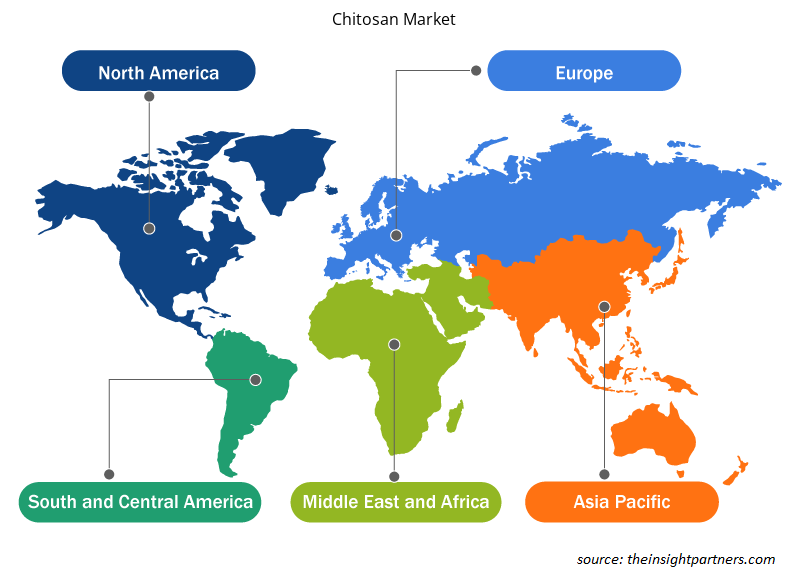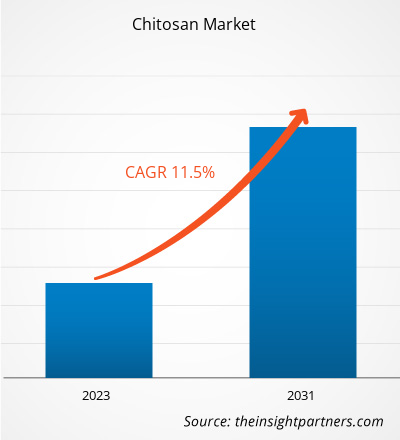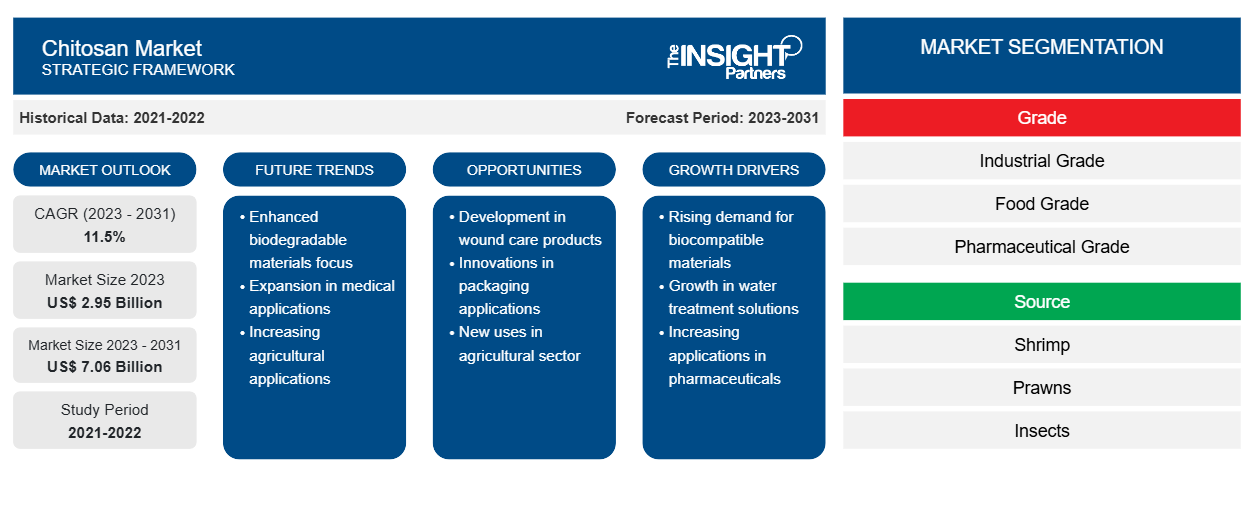Si prevede che la dimensione del mercato del chitosano raggiungerà i 7,06 miliardi di dollari entro il 2031, rispetto ai 2,95 miliardi di dollari del 2023. Si prevede che il mercato registrerà un CAGR dell'11,5% nel 2023-2031. La crescente domanda di alternative ecologiche nei settori di utilizzo finale rimarrà probabilmente una delle principali tendenze del mercato del chitosano.
Analisi di mercato del chitosano
La multifunzionalità del chitosano e la crescente applicazione del chitosano nell'industria cosmetica hanno favorito la crescita del mercato del chitosano. È riconosciuto come un biomateriale versatile grazie alla sua non tossicità, bassa allergenicità, biodegradabilità e biocompatibilità. Grazie a queste proprietà, è utilizzato in un'ampia gamma di applicazioni come alimenti e bevande, trattamento delle acque, medicina e prodotti farmaceutici, cosmetici e prodotti agrochimici. Grazie alla sua tangibile proprietà di adsorbimento, il chitosano ha trovato un posto importante nell'applicazione del trattamento delle acque per assorbire metalli, ferro, sostanze tossiche e altre impurità dalle acque reflue. Il chitosano e i suoi derivati cationici hanno il potenziale per interagire con la cheratina per formare pellicole trasparenti ed elastiche sui capelli. Queste pellicole aiutano ad aumentare la forza dei capelli, la morbidezza dei capelli ed evitano danni ai capelli. Con la crescente domanda di prodotti per la cura dei capelli, si stima che l'applicazione del chitosano nei prodotti per la cura dei capelli aumenterà il mercato in tutto il mondo. Si stima che l'applicazione del chitosano nei prodotti per la cura dei capelli e nei cosmetici sia destinata a crescere a un ritmo rapido e contribuirà all'espansione e allo sviluppo del mercato del chitosano in tutto il mondo.
Panoramica del mercato del chitosano
Il chitosano è un polisaccaride biocompatibile e biodegradabile, derivato naturalmente dalla deacetilazione della chitina, presente nell'esoscheletro di crostacei e insetti. I gruppi funzionali presenti nel chitosano influenzano significativamente le sue proprietà, come l'attività antimicrobica, la stabilità del pH, la natura cationica e la mucoadesione. Il chitosano è disponibile in varie forme, come nanofibre, nanoparticelle, nanocompositi, perle di chitosano e pellicole di chitosano. Il chitosano è ampiamente utilizzato nel settore farmaceutico e biomedico. Inoltre, il chitosano è ampiamente ricercato per lo sviluppo di biomateriali e sistemi per l'ingegneria tissutale e lo sviluppo di farmaci.
Personalizza questo report in base alle tue esigenze
Riceverai la personalizzazione gratuita di qualsiasi report, comprese parti di questo report, o analisi a livello nazionale, pacchetto dati Excel, oltre a usufruire di grandi offerte e sconti per start-up e università
- Scopri le principali tendenze di mercato in questo rapporto.Questo campione GRATUITO includerà analisi di dati che spaziano dalle tendenze di mercato alle stime e alle previsioni.
Driver e opportunità del mercato del chitosano
Crescente applicazione del chitosano nell'industria cosmetica per favorire il mercato
La crescente enfasi sui bioingredienti e la transizione dell'industria cosmetica verso cosmetici verdi supportata da normative internazionali guidano la domanda di chitosano. Il chitosano e i suoi derivati offrono proprietà fisico-chimiche e biologiche per la formulazione di prodotti cosmetici. Uno dei benefici essenziali del chitosano nell'industria cosmetica è il suo utilizzo come agente idratante per mantenere la pelle idratata e nutrita. Il chitosano è utilizzato nella prevenzione della secchezza cutanea indotta dai raggi UV, dell'iperplasia epidermica e della formazione di rughe. La crescente applicazione del chitosano nell'industria cosmetica è uno dei principali motori della quota di mercato globale del chitosano.bioingredients and the transition of cosmetics industry towards green cosmetics supported by international regulations drive the demand for chitosan. Chitosan and its derivatives offer physicochemical and biological properties for formulating cosmetic products. One of the essential benefits of chitosan in the cosmetics industry is its utilization as a moisturizing agent to keep the skin hydrated and nourished. Chitosan is used in prevention of UV-induced skin dryness, epidermal hyperplasia, and wrinkle formation. The growing application of chitosan in the
Adozione del chitosano per lo sviluppo di nanocompositi: un'opportunità nel mercato del chitosanoNanocomposites – An Opportunity in Chitosan Market
I nanocompositi a base di chitosano offrono diverse proprietà, come una migliore resistenza meccanica, stabilità termica, proprietà barriera e altre funzionalità, rendendoli adatti a un'ampia gamma di applicazioni. I nanocompositi a base di chitosano sono utilizzati in applicazioni agricole per fertilizzanti e pesticidi a rilascio controllato. Viene utilizzato per migliorare la crescita delle piante e proteggere dagli agenti patogeni. Viene anche utilizzato come materiale attivo per l'imballaggio alimentare. Pertanto, si prevede che l'adozione del chitosano per lo sviluppo di nanocompositi avrà un impatto positivo sul mercato del chitosano.
Analisi della segmentazione del rapporto di mercato del chitosano
I segmenti chiave che hanno contribuito alla derivazione dell'analisi di mercato del chitosano sono grado, fonte e applicazione.
- In base al grado, il mercato del chitosano è suddiviso in grado industriale, grado alimentare e grado farmaceutico. Il segmento di grado industriale ha detenuto una quota di mercato maggiore nel 2023.
- In base alla fonte, il mercato è segmentato in gamberetti, gamberi, insetti, granchi e altri. Il segmento dei gamberetti ha detenuto la quota maggiore del mercato nel 2023.
- In termini di applicazione, il mercato è categorizzato in trattamento delle acque, alimenti e bevande, biomedicina e prodotti farmaceutici, cosmetici e altri. Il segmento del trattamento delle acque ha dominato il mercato nel 2023.
Analisi della quota di mercato del chitosano per area geografica
L'ambito geografico del rapporto sul mercato del chitosano è suddiviso principalmente in cinque regioni: Nord America, Asia Pacifico, Europa, Medio Oriente e Africa e Sud America/Sud e Centro America.
L'Asia Pacifica ha dominato il mercato del chitosano. Fattori come il rapido sviluppo di settori di utilizzo finale come il trattamento delle acque, alimenti e bevande, biomedicina e prodotti farmaceutici e cosmetici in Giappone, Cina, India e Corea del Sud stanno aumentando la domanda di chitosano nella regione Asia Pacifica. Ad esempio, prodotti come la glucosamina e gli oligosaccaridi di chit sono considerati sicuri per l'uso negli integratori alimentari, secondo la Korea Food & Drug Administration. Allo stesso modo, in Giappone, è archiviato negli additivi alimentari nell'elenco fornito dalla Japan Food Chemical Research Foundation. La crescente domanda di chitosano nell'Asia Pacifica è guidata principalmente dal trattamento delle acque, dagli alimenti e dalle bevande e dalle applicazioni farmaceutiche. Si prevede che anche la crescente domanda dalla produzione di pelle artificiale e nella medicazione delle ferite avrà un impatto positivo sulla crescita del mercato del chitosano nell'Asia Pacifica.
Approfondimenti regionali sul mercato del chitosano
Le tendenze regionali e i fattori che influenzano il mercato del chitosano durante il periodo di previsione sono stati ampiamente spiegati dagli analisti di Insight Partners. Questa sezione discute anche i segmenti e la geografia del mercato del chitosano in Nord America, Europa, Asia Pacifico, Medio Oriente e Africa, e Sud e Centro America.

- Ottieni i dati specifici regionali per il mercato del chitosano
Ambito del rapporto sul mercato del chitosano
| Attributo del report | Dettagli |
|---|---|
| Dimensioni del mercato nel 2023 | 2,95 miliardi di dollari USA |
| Dimensioni del mercato entro il 2031 | 7,06 miliardi di dollari USA |
| CAGR globale (2023-2031) | 11,5% |
| Dati storici | 2021-2022 |
| Periodo di previsione | 2023-2031 |
| Segmenti coperti | Per grado
|
| Regioni e Paesi coperti | America del Nord
|
| Leader di mercato e profili aziendali chiave |
|
Densità degli attori del mercato: comprendere il suo impatto sulle dinamiche aziendali
Il mercato del Chitosan Market sta crescendo rapidamente, spinto dalla crescente domanda degli utenti finali dovuta a fattori quali l'evoluzione delle preferenze dei consumatori, i progressi tecnologici e una maggiore consapevolezza dei benefici del prodotto. Con l'aumento della domanda, le aziende stanno ampliando le loro offerte, innovando per soddisfare le esigenze dei consumatori e capitalizzando sulle tendenze emergenti, il che alimenta ulteriormente la crescita del mercato.
La densità degli operatori di mercato si riferisce alla distribuzione di aziende o società che operano in un particolare mercato o settore. Indica quanti concorrenti (operatori di mercato) sono presenti in un dato spazio di mercato in relazione alle sue dimensioni o al valore di mercato totale.
Le principali aziende che operano nel mercato del chitosano sono:
- KitoSano SL
- Biopolimeri avanzati AS
- Società FMC
- Società Bio GTC
- Prodotti farmaceutici Golden-Shell
- Heppe Medical Chitosano GmbH
Disclaimer : le aziende elencate sopra non sono classificate secondo un ordine particolare.

- Ottieni una panoramica dei principali attori del mercato del chitosano
Notizie e sviluppi recenti sul mercato del chitosano
Il mercato del chitosano viene valutato raccogliendo dati qualitativi e quantitativi post-ricerca primaria e secondaria, che includono importanti pubblicazioni aziendali, dati associativi e database. Di seguito è riportato un elenco degli sviluppi nel mercato per innovazioni, espansione aziendale e strategie:
- A marzo 2023, Heppe Medical Chitosan GmbH ha sviluppato una nuova tecnologia del chitosano per il rilascio efficiente di principi attivi mRNA. La tecnologia mira a garantire che i farmaci per il trattamento di gravi malattie possano essere meglio assorbiti e trattati dall'organismo. (Fonte: Heppe Medical Chitosan GmbH, comunicato stampa)
- Nel marzo 2023, i ricercatori dell'Università di Stoccarda hanno sviluppato un materiale composito verde a base di lino e chitosano. (Fonte: Università di Stoccarda, Newsletter)
- Nel novembre 2022, Alpha Chitin e Novochizol SA hanno annunciato una joint venture per produrre un polisaccaride a base di chitosano. (Fonte: Novochizol SA, comunicato stampa)
Copertura e risultati del rapporto sul mercato del chitosano
Il rapporto "Dimensioni e previsioni del mercato del chitosano (2021-2031)" fornisce un'analisi dettagliata del mercato che copre le seguenti aree:
- Dimensioni e previsioni del mercato a livello globale, regionale e nazionale per tutti i segmenti di mercato chiave coperti dall'ambito
- Dinamiche di mercato come fattori trainanti, vincoli e opportunità chiave
- Principali tendenze future
- Analisi dettagliata delle cinque forze PEST/Porter e SWOT
- Analisi di mercato globale e regionale che copre le principali tendenze di mercato, i principali attori, le normative e gli sviluppi recenti del mercato
- Analisi del panorama industriale e della concorrenza che copre la concentrazione del mercato, l'analisi della mappa di calore, i principali attori e gli sviluppi recenti
- Profili aziendali dettagliati
- Analisi storica (2 anni), anno base, previsione (7 anni) con CAGR
- Analisi PEST e SWOT
- Valore/volume delle dimensioni del mercato - Globale, Regionale, Nazionale
- Industria e panorama competitivo
- Set di dati Excel
Report recenti
Testimonianze
Motivo dell'acquisto
- Processo decisionale informato
- Comprensione delle dinamiche di mercato
- Analisi competitiva
- Analisi dei clienti
- Previsioni di mercato
- Mitigazione del rischio
- Pianificazione strategica
- Giustificazione degli investimenti
- Identificazione dei mercati emergenti
- Miglioramento delle strategie di marketing
- Aumento dell'efficienza operativa
- Allineamento alle tendenze normative























 Ottieni un campione gratuito per - Mercato del chitosano
Ottieni un campione gratuito per - Mercato del chitosano